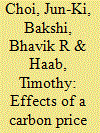| Srl | Item |
| 1 |
ID:
097512


|
|
|
|
|
| Publication |
2010.
|
| Summary/Abstract |
Despite differences in their implementation, most carbon policies aim to have similar outcomes: effectively raising the price of carbon-intensive products relative to non-carbon-intensive products. While it is possible to predict the simple broad-scale economic impacts of raising the price of carbon-intensive products-the demand for non-carbon-intensive products will increase-understanding the economic and environmental impacts of carbon policies throughout the life cycle of both types of products is more difficult. Using the example of a carbon tax, this study proposes a methodology that integrates short-term policy-induced consumer demand changes into the input-output framework to analyze the environmental and economic repercussions of a policy. Environmental repercussions include the direct and the indirect impacts on emissions, materials flow in the economy, and the reliance on various ecosystem goods and services. The approach combines economic data with data about physical flow of fossil fuels between sectors, consumption of natural resources and emissions from each sector. It applies several input-output modeling equations sequentially and uses various levels of aggregation/disaggregation. It is illustrated with the data for the 2002 U.S. economy and physical flows. The framework provides insight into the short-term complex interactions between carbon price and its economic and environmental effects.
|
|
|
|
|
|
|
|
|
|
|
|
|
|
|
|
| 2 |
ID:
103457


|
|
|
|
|
| Publication |
2011.
|
| Summary/Abstract |
This research builds a technology-based bottom-up model to estimate the performance of China's coal-fired electricity industry on resource consumption and environmental emissions. From the integrated estimation of three scenarios characterizing different stages of technology innovation in 2007-2030, technology innovation is proven to be the determinant in decreasing resource use and environmental effects from electricity production, but analysis based on current policies reveals some doubt in achieving the coal consumption intensity control target. Constrained with national control targets, the best route of technology innovation is calculated by integrated benefit targeting optimization. Supercritical (SC) and ultra-supercritical (USC) pressure boilers, flue gas desulfurization (FGD) and closed-cycle wet cooling with a high circulation ratio will be the mainstream technologies before 2030 based on current policy. It is inevitable to close or reconstruct small power plants from the late 2010s, and integrated gasification combined cycle (IGCC) and pressurized fluidized bed combustion combined cycle (PFBC-CC) plants will show a competitive advantage in the late 2020s. However, air cooling and FGD systems will expand slower than the authorities' expectation, while higher water prices and SO2 charges promote the expansion. Stricter restrictions are also found to be positive for technological progress.
|
|
|
|
|
|
|
|
|
|
|
|
|
|
|
|